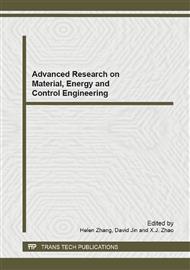[1]
Wei. K.: The Report on the Corrosion in China (Chemistry Industry Publication, China 2003).
Google Scholar
[2]
Xinde. B.: Materials Corrosion and Control (Tsinghua University publication, China 2005).
Google Scholar
[3]
Baoming. W.: Metal Corrosion Theory and Application (Chemistry Industry Publication, China 1984).
Google Scholar
[4]
Ming. G.: G. Metal Corrosion Theory and Corrosion Control (Chemistry Industry Publication, China 2009).
Google Scholar
[5]
Shizhe. S.: Researching Methods of Corrosive Electrochemistry (Chemistry Industry Publication, China 1994).
Google Scholar
[6]
Bockris. J. O.: Surface Electrochemistry (Plenum Press, United States, 1988).
Google Scholar
[7]
Tianqing. Liu, Aihua Zhou, Rong Guo. Acta Physico-Chimica Sinica, Vol. 16 (2000), p.899.
Google Scholar
[8]
Daoxin. L.: Materials Corrosion and Protection (Northwestern Polytechnical University Publication, China 2006).
Google Scholar
[9]
China Industry Anticorrosion Technology Association: Handbook of Metal Anticorrosion (Shanghai scientific & Technical Publishers, China 1989).
Google Scholar
[10]
S. Muralidharan, M.A. Quraishi, S.V.K. Iyer, Corros. Sci. Vol. 37 (1995), p.1739.
Google Scholar
[11]
S.K. Shukla, M.A. Quraishi, Corros. Sci. Vol. 51 (2009), p. (1990).
Google Scholar
[12]
M.A. Quraishi, I. Ahamad, A.K. Singh, S.K. Shukla, B. Lal, V. Singh, Mater. Chem. Phys. Vol. 112 (2008), p.1035.
Google Scholar
[13]
R.S. Goncalves, D.S. Azambuja, A.M. Serpa Lucho, Corros. Sci. Vol. 44 (2002), p.467.
Google Scholar
[14]
E. Machnikova, K.H. Whitmire, N. Hackerman, Electrochim. Acta Vol. 53 (2008), p.6024.
Google Scholar
[15]
Tianqing. Liu, Aihua Zhou, Rong Guo. Acta Physico-Chimica Sinica, Vol. 16 (2000), p.899.
Google Scholar
[16]
G.N. Mu, T.P. Zhao, M. Liu, T. Gu, Corrosion Vol. 52 (1996), p.853.
Google Scholar
[17]
G.A. Petersson, M.A. Al-Laham, J. Chem. Phys. Vol. 94 (1991), p.6081.
Google Scholar


